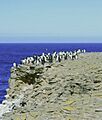List of Ramsar sites in British Overseas Territories facts for kids
This article is about special places called Ramsar sites found in the British Overseas Territories. These are wetlands that are super important for nature around the world. They are recognized under a global agreement called the Ramsar Convention. Right now, the British Overseas Territories have 16 of these amazing sites.
Contents
- What are Ramsar Sites?
- Ramsar Sites in Bermuda
- Ramsar Sites in the British Indian Ocean Territory
- Ramsar Sites in the British Virgin Islands
- Ramsar Sites in the Turks and Caicos Islands
- Ramsar Sites in the Cayman Islands
- Ramsar Sites in Cyprus
- Ramsar Sites in the Falkland Islands
- Ramsar Sites in Saint Helena, Ascension and Tristan da Cunha
- Images for kids
- See also
What are Ramsar Sites?
A Ramsar site is a wetland that has been chosen because it's very important for plants, animals, or the environment. Wetlands are places like marshes, swamps, lakes, rivers, or even areas of sea that are not too deep. They are like nature's sponges, helping to clean water and providing homes for many different creatures. The Ramsar Convention is an international treaty that helps countries protect these vital areas.
Why are Wetlands Important?
Wetlands are incredibly important for many reasons:
- They are home to unique plants and animals, including many rare or endangered species.
- They help control floods by soaking up extra water.
- They filter pollution, making water cleaner.
- They provide places for birds to rest and feed during their long migrations.
- They can even help fight climate change by storing carbon.
Ramsar Sites in Bermuda
Bermuda has several small but important Ramsar sites, mostly made up of marshes and ponds. These places are vital for local wildlife.
Hungry Bay Mangrove Swamp
This small swamp in Paget Parish became a Ramsar site on May 11, 1999. It's a key area for mangrove trees, which are special trees that can grow in salty water.
Lover's Lake Nature Reserve
Located in St. George's Parish, this nature reserve is another small wetland. It was also designated on May 11, 1999.
Paget Marsh
Also in Paget Parish, Paget Marsh is a larger wetland. It's a crucial spot for different types of crustaceans, like native crabs. It's also a winter home for birds such as the yellow-crowned night heron and the belted kingfisher. This site was recognized on May 11, 1999.
Pembroke Marsh East
This marsh in Pembroke Parish is another one of Bermuda's Ramsar sites, designated on May 11, 1999.
Somerset Long Bay Pond
A very small pond in Sandys Parish, this site became a Ramsar wetland on May 11, 1999.
Spittal Pond
Found in Smith's Parish, Spittal Pond is a significant wetland area in Bermuda. It was designated on May 11, 1999.
Warwick Pond
In Warwick Parish, Warwick Pond is another one of Bermuda's important wetlands, recognized on May 11, 1999.
Ramsar Sites in the British Indian Ocean Territory
This territory has one very large and important Ramsar site.
Diego Garcia
Diego Garcia is a huge tropical coral atoll in the central Indian Ocean. It became a Ramsar site on July 4, 2001, because of its unique coral reef environment and the marine life it supports.
Ramsar Sites in the British Virgin Islands
The British Virgin Islands are home to one special Ramsar site.
Western Salt Ponds of Anegada
Located on the island of Anegada, this site includes mudflats, a mangrove forest, and salty lagoons. It's a very important home for Caribbean flamingos and the endangered Anegada rock iguana. This wetland was designated on May 11, 1999.
Ramsar Sites in the Turks and Caicos Islands
These islands have one very large Ramsar site covering multiple islands.
North, Middle and East Caicos Islands
This huge coastal wetland site covers parts of North Caicos, Middle Caicos, and East Caicos Islands. It's especially important for the West Indian whistling duck, which is a vulnerable species. This area became a Ramsar site on June 27, 1990.
Ramsar Sites in the Cayman Islands
The Cayman Islands have one key Ramsar site known for its bird population.
Booby Pond and Rookery
On Little Cayman island, this site is a salty lagoon that is not connected to the sea. It's famous for having the largest group of red-footed booby birds in the Caribbean. It was designated on September 21, 1994.
Ramsar Sites in Cyprus
Cyprus has one Ramsar site within the British Sovereign Base Areas.
Akrotiri
Located on the Akrotiri Peninsula, this site includes marshes, a salt lake, and salt flats. It's an important wetland for many bird species. It became a Ramsar site on March 20, 2003.
Ramsar Sites in the Falkland Islands
The Falkland Islands have two important Ramsar sites, known for their unique wildlife.
Bertha's Beach
This sandy beach on East Falkland is a habitat for several threatened species, including the Falkland steamer duck. It was designated on September 24, 2001.
Sea Lion Island
Near Lafonia, Sea Lion Island is a crucial breeding spot for the southern sea lion and the southern elephant seal. It became a Ramsar site on September 24, 2001.
Ramsar Sites in Saint Helena, Ascension and Tristan da Cunha
This territory includes several remote islands with important Ramsar sites.
Gough Island
One of the five islands that make up Tristan da Cunha, Gough Island is a very important breeding site for threatened species of birds. These include the sooty albatross and the northern rockhopper penguin. It was designated on November 20, 2008.
Inaccessible Island
Also part of Tristan da Cunha, Inaccessible Island is an extinct volcano. It's a vital breeding ground for many seabirds and landbirds that are found nowhere else in the world. It became a Ramsar site on November 20, 2008.
Images for kids
See also
- Ramsar Convention
- List of Ramsar sites worldwide






